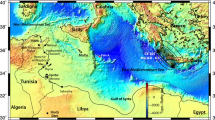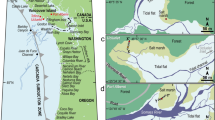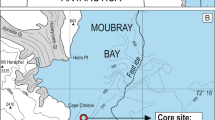Abstract
Giant tsunamis, generated by submarine landslides in the Hawaiian Islands, have been thought to be responsible for the deposition of chaotic gravels high on the southern coastal slopes of the islands of Lana'i and Moloka'i, Hawaii. Here we investigate this hypothesis, using uranium–thorium dating of the Hulopoe gravel (on Lana'i) and a study of stratigraphic relationships, such as facies changes and hiatuses, within the deposit. The Hulopoe gravel contains corals of two age groups, representing marine isotope stages 5e and 7 (∼135,000 and 240,000 years ago, respectively), with significant geographical and stratigraphic ordering. We show that the Hulopoe gravel was formed by multiple depositional events, separated by considerable periods of time, thus invalidating the main premise of the ‘giant wave’ hypothesis. Instead, the gravels were probably deposited during interglacial periods (when sea level was relatively high) by typical Hawaiian shoreline processes such as seasonal wave patterns, storm events and possibly ‘normal’ tsunamis, and reached their present height by uplift of Lana'i.
This is a preview of subscription content, access via your institution
Access options
Subscribe to this journal
Receive 51 print issues and online access
$199.00 per year
only $3.90 per issue
Buy this article
- Purchase on Springer Link
- Instant access to full article PDF
Prices may be subject to local taxes which are calculated during checkout



Similar content being viewed by others
References
Stearns, H. T. Geology and ground-water resources of the islands of Lana'i and Kahoolawe, Hawaii. Hawaii Division of Hydrography/US Geol. Survey Bull. 6, 1–177 (1940).
Moore, J. G. & Moore, G. W. Deposit from a giant wave on the island of Lana'i, Hawaii. Science 226, 1312–1315 (1984).
Stearns, H. T. Quaternary shorelines in the Hawaiian Islands. Bishop Museum Press Bull. 237, 57 (1978).
Moore, G. W. & Moore, J. G. Large-scale bedforms in boulder gravel produced by giant waves in Hawaii. Geol. Soc. Am. Spec. Pap. 229, 101–110 (1988).
Moore, J. G. & Fornari, D. J. Drowned reefs as indicators of the rate of subsidence of the island of Hawaii. J. Geol. 92, 752–759 (1984).
Moore, J. G. in Volcanism in Hawaii (eds Decker, R. W., Wright, T. L. & Staufer, P. H.) Ch. 2, 85–100 (USGS Professional Paper 1350, Washington DC, 1987).
Nisbet, E. & Piper, D. J. W. Giant submarine landslides. Nature 392, 329–330 (1998).
McMurtry, G. M. et al. Stratigraphic constraints on the timing and emplacement of the Alika 2 giant Hawaiian submarine landslide. J. Volcanol. Geotherm. Res. 94, 35–58 (1999).
Young, R. W. & Bryant, E. A. Catastrophic wave erosion on the southeast coast of Australia: impact of the Lana'i tsunamis ca. 105ka? Geology 20, 199–202 (1992).
Moore, J. G., Bryan, W. B. & Ludwig, K. R. Chaotic deposition by a giant wave, Molokai, Hawaii. Geol. Soc. Am. Bull. 106, 962–967 (1994).
Bard, E. et al. Pleistocene sea levels and tectonic uplift based on dating of corals from Sumba Island, Indonesia. Geophys. Res. Lett. 23, 1473–1476 (1996).
Rubin, K. H., Sherman, C. E. & Fletcher, C. H. III Ages of emerged coral deposits in Kapihaa Gulch, Lana'i, Hawaiian Islands and speculation about their environment of deposition. Trans. Am. Geophys. Union 76, F307 (1995).
Felton, E. A., Crook, A. W. & Keating, B. W. The Hulopoe Gravel, Lana'i, Hawaii: New sedimentological data and their bearing on the “Giant Wave” (mega-tsunami) emplacement hypothesis. Pure Appl. Geophys. 157, 1257–1284 (2000).
Muhs, D. R. & Szabo, B. J. New uranium-series ages of the Waimanalo Limestone, O'ahu, Hawaii: Implications for sea level during the last interglacial period. Mar. Geol. 118, 315–326 (1994).
Szabo, B. J., Ludwig, K. R., Muhs, D. R. & Simmons, K. R. Thorium-230 ages of corals and duration of the last interglacial sea-level high stand on O'ahu, Hawaii. Science 266, 93–96 (1994).
Sherman, C. E., Fletcher, C. H. & Rubin, K. H. Marine and meteoric diagenesis of Pleistocene carbonates from a nearshore submarine terrace, O'ahu, Hawaii. J. Sedim. Res. 69, 1083–1097 (1999).
Fletcher, C. H. III & Jones, A. T. Sea-level highstand recorded in Holocene shoreline deposits on O'ahu, Hawaii. J. Sedim. Res. 66, 632–641 (1996).
Henderson, G. M. & Slowey, N. C. Evidence from U-Th dating against Northern Hemisphere forcing of the penultimate deglaciation. Nature 404, 61–66 (2000).
Bassinot, F. C. et al. The astronomical theory of climate and the age of the Brunhes-Matuyama magnetic reversal. Earth Planet. Sci. Lett. 126, 91–108 (1994).
Brückner, H. & Radtke, U. Fossile strände and korallenbänke auf O'ahu, Hawaii. Essener Geogr. Arb. 17, 291–308 (1989).
Grigg, R. W. & Jones, A. T. Uplift caused by lithospheric flexure in the Hawaiian Archipelago as revealed by elevated coral deposits. Mar. Geol. 141, 11–25 (1997).
Johnson, C. & Mader, C. L. Modeling the 105 ka Lana'i tsunami. Sci. Tsunam. Haz. 12, 33–38 (1994).
Moore, A. L. Landward fining in onshore gravel as evidence for a late Pleistocene tsunami on Molokai, Hawaii. Geology 28, 247–250 (2000).
Dawson, A. G. & Shi, S. Tsunami Deposits. Pure Appl. Geophys. 157, 875–897 (2000).
Harmon, R. S. et al. U-series and amino acid racemization geochronology of Bermuda: implications for eustatic sea level fluctuation over the past 250,000 years. Paleogeogr. Paleoclimatol. Paleoecol. 44, 41–70 (1983).
Gallup, C. D., Edwards, R. L. & Johnson, R. G. The timing of high sea levels over the past 200,000 years. Science 263, 796–800 (1994).
Chen, J. H., Curran, H. A., White, B. & Wasserburg, G. J. Precise chronology of the last interglacial period: 234U-230Th data from fossil coral reefs in the Bahamas. Geol. Soc. Am. Bull. 103, 82–97 (1991).
Cox, D. C. The Lanai earthquake of February 1871 50 (Univ. Hawaii Environmental Center, Honolulu, Hawaii, 1985).
Watts, A. B. & Ten Brink, U. S. Crustal structure, flexure, and subsidence history of the Hawaiian Islands. J. Geophys. Res. 94, 10473–10500 (1989).
Wessel, P. & Keating, B. H. Temporal variations of flexural deformation in Hawaii. J. Geophys. Res. 99, 2747–2756 (1994).
Smith, J. R. & Wessel, P. Isostatic consequences of giant landslides on the Hawaiian ridge. Pure Appl. Geophys. 157, 1097–1114 (2000).
Rubin, K. H. Analysis of 232Th-230Th in volcanic rocks: a comparison of thermal ionization mass spectrometry and other methodologies. Chem. Geol. (in the press).
Edwards, R. L., Chen, J. H. & Wasserburg, G. J. 238U-234U-230Th-232Th systematics and the precise measurement of time over the past 500,000 years. Earth Planet. Sci. Lett. 81, 175–192 (1986/87).
Chen, J. H., Edwards, R. L. & Wasserburg, G. J. 238U, 234U, and 232Th in seawater. Earth Planet. Sci. Lett. 80, 241–251 (1986).
Stirling, C. H., Esat, T. M., Lambeck, K. & McCulloch, M. T. Timing and duration of the last interglacial: evidence for a restricted interval of widespread coral reef growth. Earth Planet. Sci. Lett. 160, 745–762 (1998).
Hamelin, B., Bard, E., Zindler, A. & Fairbanks, R. G. 234U-238U mass spectrometry of corals: how accurate is the U-Th age of the last interglacial period. Earth Planet. Sci. Lett. 106, 169–180 (1991).
Henderson, G. M., Cohen, A. S. & O'Nions, R. K. 234U-238U ratios and 230Th ages for Hateruma Atoll corals: implications for coral diagenesis and seawater 234U-238U ratios. Earth Planet. Sci. Lett. 115, 65–73 (1993).
Acknowledgements
We thank E. Grossman and M. Coyne for field assistance, K. Spencer for maintaining the UH Isotope Lab, J. Moore, W. Bryan, A. Felton, R. Grigg, C. Glenn, T. Jones, P. Wessel and B. Keating for enlivening discussions, the Manele Bay Hotel for access and D. Muhs for a review. This work was supported by the University of Hawaii, Seagrant, the US Geological Survey and the US National Science Foundation.
Author information
Authors and Affiliations
Corresponding author
Rights and permissions
About this article
Cite this article
Rubin, K., Fletcher, C. & Sherman, C. Fossiliferous Lana'i deposits formed by multiple events rather than a single giant tsunami. Nature 408, 675–681 (2000). https://doi.org/10.1038/35047008
Received:
Accepted:
Issue Date:
DOI: https://doi.org/10.1038/35047008
This article is cited by
-
A qualitative review of tsunamis in Hawaiʻi
Natural Hazards (2023)
-
The formation of biogenic reef stone: from coral skeleton to reef rubble
Journal of Oceanography (2022)
-
The orphan Sanriku tsunami of 1586: new evidence from coral dating on Kaua‘i
Natural Hazards (2017)
-
Offshore depositional sequence of 2004 tsunami from Chennai, SE coast of India
Natural Hazards (2012)
-
Process-sedimentological challenges in distinguishing paleo-tsunami deposits
Natural Hazards (2012)
Comments
By submitting a comment you agree to abide by our Terms and Community Guidelines. If you find something abusive or that does not comply with our terms or guidelines please flag it as inappropriate.



